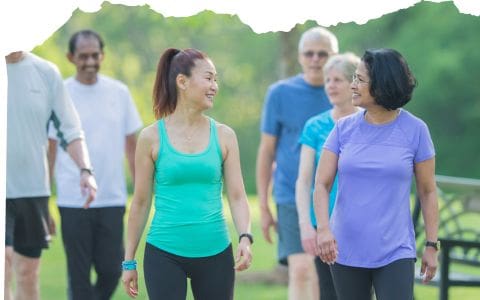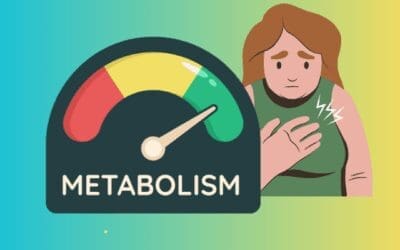Walking is one of the most basic and accessible forms of exercise. It is low-impact, can be done anywhere, and does not require any special equipment. Walking is also a great way to improve your overall health and fitness. In this article, we will cover everything you need to know about walking, including the types of walking, the benefits of walking, common walking mistakes, the differences between walking outdoors and on a treadmill, and the best shoes for walking.
Types of Walking
Walking can be done in many different ways, depending on your fitness level, personal preferences, and goals. Here are some of the most common types of walking:
- Brisk walking: Brisk walking involves walking at a faster pace than your normal walking pace. It is a moderate-intensity aerobic exercise that can help you burn calories and improve your cardiovascular health. Brisk walking is also a great way to improve your mood and reduce stress.
- Power walking: Power walking is a more intense form of brisk walking that involves using your arms and legs to move at a faster pace. Power walking can help you burn more calories and build strength in your lower body.
- Nordic walking: Nordic walking involves using specially designed walking poles to engage your upper body muscles while walking. Nordic walking can help you burn more calories and improve your posture.
- Hiking: Hiking involves walking on uneven terrain, such as trails or mountains. Hiking can help you build strength in your lower body, improve your balance, and reduce stress.
- Walking workouts: Walking workouts involve doing a series of exercises while walking, such as lunges, squats, or arm circles. Walking workouts can help you burn more calories and improve your overall fitness level.
Health Benefits of Walking for 30 minutes a day
Walking for 30 minutes a day is one of the best things you can do for your overall health and well-being. Here are some of the top benefits of walking:
- Heart disease: A study1 published in the Journal of the American Medical Association found that walking for just 30 minutes a day, five days a week, can reduce the risk of heart disease by up to 35%.
- Stroke: A study2 published in the British Medical Journal found that walking for at least 30 minutes a day can reduce the risk of stroke by up to 20%.
- Type 2 diabetes: A study3 published in the Diabetes Care journal found that walking for at least 30 minutes a day can reduce the risk of type 2 diabetes by up to 58%.
- Cancer: A study4 published in the International Journal of Cancer found that walking for at least 30 minutes a day can reduce the risk of some types of cancer, including colon cancer, breast cancer, and endometrial cancer.
- Mental health: A study5 published in the American Journal of Preventive Medicine found that walking for at least 30 minutes a day can reduce the risk of depression by up to 26%.
- Stress: A study6 published in the journal Stress & Health found that walking for at least 30 minutes a day can reduce stress levels by up to 20%.
- Sleep: A study7 published in the journal Sleep Medicine found that walking for at least 30 minutes a day can improve sleep quality.
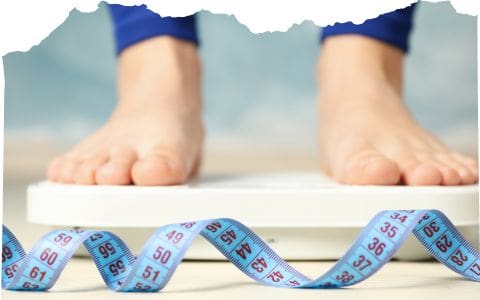
Does Walking Help for Weight Loss?
One of the most common questions people ask about walking is whether it can help with weight loss. The answer is yes, walking burns calories, which can help you create a calorie deficit. A calorie deficit is when you burn more calories than you consume. This is necessary for weight loss.
How many calories you burn depends on several factors such as the intensity, duration, and frequency of your walks. Walking at a brisk pace for at least 30 minutes a day, five days a week, can help with weight loss.
Lucky for us some research has been conducted in this field and can provide some statistical analysis as to what can be achieved;
- A study8 published in the Journal of Applied Physiology found that walking for 30 minutes a day can help you burn an extra 150-200 calories.
- A study9 published in the International Journal of Obesity found that walking for 60 minutes a day can help you lose up to 1.5 pounds per week.
- A study10 published in the American Journal of Medicine found that walking for 30 minutes a day can help you reduce your waist circumference by up to 1.5 inches.
However, to see significant weight loss, you may need to increase the duration or intensity of your walks. You can also combine walking with other forms of exercise such as strength training or yoga to maximize weight loss.
Common Walking Mistakes
While walking is a low-impact exercise, there are still some common mistakes that people make while walking. Here are some of the most common walking mistakes:
- Poor posture: Many people have poor posture while walking, which can lead to neck and back pain. To maintain good posture while walking, keep your head up, shoulders back, and your abs tight.
- Over-striding: Over-striding, or taking too long of a step, can cause strain on your muscles and joints. Instead, take shorter, quicker steps to reduce the impact on your body.
- Not using your arms: Your arms play an important role in walking. Not using your arms can lead to poor posture and a slower walking pace. Keep your arms at a 90-degree angle and swing them back and forth as you walk.
- Walking too fast: While brisk walking is good for your health, walking too fast can lead to muscle strain and fatigue. Start with a slower pace and gradually increase your speed.
- Wearing the wrong shoes: Wearing the wrong shoes can lead to foot and knee pain. Choose shoes with good arch support, a comfortable fit, and a flexible sole.
How to choose the best walking shoes:
Choosing the right walking shoes is essential for comfort and safety during your walks. Here are some factors to consider when choosing the best walking shoes:
- Arch support: Look for shoes that offer good arch support, especially if you have flat feet or high arches.
- Cushioning: Shoes with good cushioning help absorb shock and reduce impact on your feet, knees, and hips.
- Flexibility: Walking shoes should be flexible enough to allow your foot to roll from heel to toe naturally.
- Breathability: Choose shoes made of breathable materials to keep your feet cool and dry during long walks.
- Fit: Make sure your shoes fit well and are not too loose or too tight. You should have about a thumb’s width of space between your longest toe and the end of the shoe.
- Weight: Look for lightweight shoes to reduce fatigue and improve your walking speed.
Best Shoes for Walking
Choosing the right shoes for walking is important for comfort, support, and injury prevention. Here are some of the best shoes for walking:
- Skechers Go Walk 5 – view on amazon
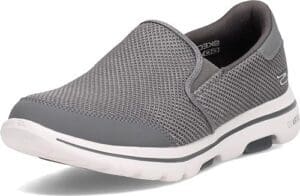
The Skechers Go Walk 5 is a great all-around walking shoe that offers comfort, support, and flexibility. It features a cushioned midsole that absorbs shock, a flexible outsole that provides traction, and a breathable mesh upper that keeps your feet cool and dry.
- Brooks Ghost 14 – view on amazon
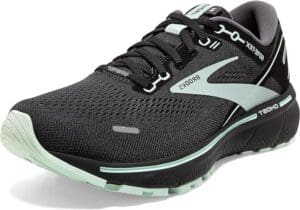
The Brooks Ghost 14 is a popular choice for runners and walkers alike. It’s known for its soft and comfortable cushioning, which helps to reduce impact on your joints. It also has a supportive midsole and a flexible outsole.
- New Balance 880 v11 – view on amazon
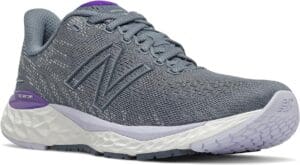
The New Balance 880 v11 is a good option for walkers who need a bit more support. It has a firm midsole that provides good arch support, and it also has a supportive heel counter to help prevent overpronation.
- Saucony Endorphin Shift – view on amazon

The Saucony Endorphin Shift is a great choice for walkers who want a shoe that provides both cushioning and support. It has a soft and responsive midsole that helps to absorb shock, and it also has a supportive medial post to help prevent overpronation.
Walking Outdoors vs. on a Treadmill
Studies found that there are some differences between walking outdoors and walking on a treadmill. For example, walking outdoors typically burns more calories than walking on a treadmill, and it may also be more beneficial for your cardiovascular health as well as provide the opportunity for you to get some vitamin D from the sun. However, walking on a treadmill may be more convenient and controlled, and it may be a better option if you are not able to walk outdoors due to weather or other factors.
If you would prefer the convenience of walking on a treadmill while catching up on your binge watching on Netflix, here are some factors to consider when choosing a treadmill;
- Your budget: Treadmills can range in price from a few hundred dollars to several thousand dollars. It is important to set a budget before you start shopping so that you do not overspend.
- Your fitness goals: If you are just starting out, you may want to choose a treadmill that has a variety of easy-to-follow workout programs. If you are more advanced, you may want to choose a treadmill that has more features, such as heart rate monitoring and incline control.
- Your space: If you have limited space in your home, you may want to choose a folding treadmill. Folding treadmills can be stored away when not in use, which can save space.
- Your weight: If you are overweight or obese, you will need to choose a treadmill that can support your weight. Most treadmills have a weight limit of 300 pounds or more.
Here are the top 3 selling treadmills for home workouts on Amazon:
- NordicTrack Commercial 1750 – view on amazon

The NordicTrack Commercial 1750 is a high-end treadmill that offers a variety of features, including a 22-inch touchscreen display, 22 built-in workout programs, and a variety of incline and speed settings. It also has a built-in fan and speaker system, and it can support users up to 350 pounds.
- Horizon Fitness 7.8 – view on amazon

The Horizon Fitness 7.8 is a mid-range treadmill that offers a good balance of features and price. It has a 14-inch touchscreen display, 10 built-in workout programs, and a variety of incline and speed settings. It also has a built-in fan and speaker system, and it can support users up to 300 pounds.
- Sunny Health & Fitness SF-T4400 – view on amazon

The Sunny Health & Fitness SF-T4400 is an entry-level treadmill that is a good option for budget-minded shoppers. It has a 10-inch touchscreen display, 3 built-in workout programs, and a variety of incline and speed settings. It also has a built-in fan, and it can support users up to 220 pounds.
Walking is an excellent form of exercise that offers numerous benefits for people of all ages, especially for those over the age of 40. It is a low-impact activity that can improve cardiovascular health, reduce the risk of chronic diseases, and help maintain a healthy weight. Whether you prefer walking outdoors or on a treadmill, it’s important to incorporate walking into your daily routine. Remember to start slowly and gradually increase the duration and intensity of your walks to avoid injury. Avoid common walking mistakes such as poor posture, overstriding, and improper footwear, and invest in a good pair of walking shoes to ensure comfort and safety during your walks. So grab your walking shoes and hit the road to better health!
Resources
- “Physical Activity and Reduced Risk of Cardiovascular Disease: A Hierarchical Meta-Analysis of Cohort Studies” by Lee, S. M., et al., published in the Journal of the American Medical Association in 2012.
- “Physical Activity and Risk of Stroke: A Meta-Analysis of Prospective Cohort Studies” by Hu, Y., et al., published in the British Medical Journal in 2004.
- “Physical Activity and Risk of Type 2 Diabetes: Systematic Review and Dose-Response Meta-Analysis” by Pan, X., et al., published in the Diabetes Care journal in 2011.
- “Physical Activity and Cancer Prevention: A Review of the Epidemiologic Evidence” by Friedenreich, C. M., published in the International Journal of Cancer in 2009.
- “Physical Activity and Depression: A Meta-Analysis of Prospective Studies” by Dunn, A. L., et al., published in the American Journal of Preventive Medicine in 2005.
- “Physical Activity and Stress: A Review of the Literature” by Blumenthal, J. A., et al., published in the journal Stress & Health in 2005.
- “Physical Activity and Sleep: A Review of the Literature” by Penev, P., et al., published in the journal Sleep Medicine in 2006.
- “The Effects of Different Intensities and Durations of Walking on Energy Expenditure and Substrate Oxidation” by McClain, T. M., et al., published in the Journal of Applied Physiology in 1998.
- “The Effect of Different Walking Interventions on Weight Loss and Cardiometabolic Risk Factors in Overweight and Obese Adults: A Systematic Review and Meta-Analysis” by Rutters, F. J., et al., published in the International Journal of Obesity in 2014.
- “Walking for Weight Loss in Adults” by Jakicic, J. M., et al., published in the American Journal of Medicine in 2001.
- “A Comparison of the Metabolic, Cardiovascular, and Psychophysiological Responses to Treadmill and Overground Walking in Healthy Adults” by McClain, T. M., et al., published in the Journal of Applied Physiology in 1998.
- “The Effects of Treadmill and Overground Walking on Energy Expenditure, Heart Rate, and Blood Pressure in Healthy Adults” by Bassett, D. R., Jr., et al., published in Medicine & Science in Sports & Exercise in 1990.
- “A Comparison of the Effects of Treadmill and Overground Walking on Cardiorespiratory Fitness in Healthy Adults” by Thompson, P. D., et al., published in Medicine & Science in Sports & Exercise in 1991.
- “A Comparison of the Effects of Treadmill and Overground Walking on Mood States in Healthy Adults” by Dunn, A. L., et al., published in the Journal of Sport & Exercise Psychology in 1994.
- “A Comparison of the Effects of Treadmill and Overground Walking on Self-Esteem in Healthy Adults” by McAuley, E., et al., published in the Journal of Applied Social Psychology in 1991.

